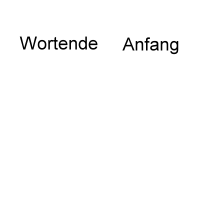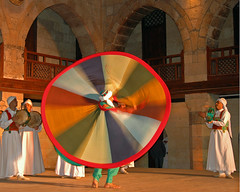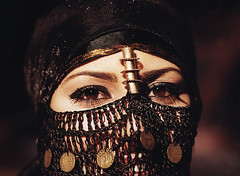Saturday, February 04, 2006
The Open Letter of Jyllands-Posten
The Open Letter of Jyllands-Posten
Friday, February 03, 2006
My opinion about the Mohamed caricature
But what do we do, instead, after we see how the Muslim world feels offended by the caricature, after we see their manifestations, arousing hatred against the West ???
We repeat the same awful caricature in other newspapers and magazines! :-( This is already not right, this is an act of confrontation done fully knowing that the Muslim world feels offended! This is already not right. Although I am not a muslim, I, too, condemn this! Hey, this was really not necessary!!! It is, as if we, the non-muslims, would stick our tongue out at all muslims, as if we would say we would not care what the muslims think and have any right to do under the shield of "freedom of press" ...
PEOPLE!!! I ASK YOU: WHERE HAS OUR CIVILIZATION GONE?
We consider our "freedom of religion" a big advantage in our civilised world. Freedom of religion, however, like real civilization, includes tolerance and understanding towards any other religion in the world. "Freedom of press" belongs to our great advancements in civilization, it is good we have a "freedom of press" to fight, with these means, against any oppression, any injustice, any totalitary regimes.
Publishing, the more so knowingly, a caricature, which offends another religion, has nothing to do with "freedom of press"! It is and will remain an act of offence!
I am only a weak, little "nobody" living in the Western world. But I would like to assure every muslim in the world who happens to read this little post in our blog that I condemn this caricature, like many other normal people who live here. That caricature is ugly. Please accept my apologies - also in the name of many other people who live here and who feel the same way! What the big newspapers and magazines did today, this in no way reflects the thinking of the majority of the normal people who live here!
Thursday, February 02, 2006
Sufi dancer in Cairo
Sufi dancers - I have heard about them under the name "Dervishes" - are muslim mystics. Love, harmony and beauty are their highest goals. But Wikipedia is, as usually, an excellent source, so let me quote them:
"As Sufi practitioners, dervishes were known as a source of wisdom, medicine, poetry, enlightment, and witticisms. For example, Mollah Nasr-ad-Din (Mulla Nasrudin, Hoja Nasrudin) had become a legend in the Near East and the Indian subcontinent (and not only Muslims)."
Ah yes, Hodsha Nasreddin ... Reminds me of my childhood, when I read fairy tales about him or watched the movies (made by USSR film studios, mainly Uzbek and Armenian studios, I think ...)
Thaa and Taa

Taa and Thaa are easy, after the Baa of yesterday. The only difference is the number of the dots and that they are now placed over the sign.
Above is Thaa - sounds like the "th" in English to me, and below is the Taa (our T).

tha ثا bath باث batha باثا bathab باثاب Tabatha تاباثا
Batabatha باتاباثا
As I do not know yet Arabic words, now Hazem helps out:
this is a wonderful way to memorize the alphabitic By saying :
Aba-tatha-Gohon
Some words that start with ت are :
تاب (Tap) which means reformed or repent .
Another is :
تثاءب (Tathaep) gaped or yawned , the ء (Hamza) is which we put on Aleph some times but hear its put on the line .
تثبت (Tathabata) , means fixated , or stabilized Also its similar to تثبيت (Tathbeet) which is the process of fixation itself so it means fixation or stabilization .
Ok Now we go to ث :
First word is an adjective and means : ثابت (Thabet) , here the thing is already fixed , so I describe it by being fixed . A lot of words can be formed then , like we say "Thapet Al Loon" which means fixed color.
Another word is ثبات (Thabaat) is the infinitive of ثابت "Thabet" , so all of these words are related, by making some examples of them and noticing the difference we can get the infinitive, past , past particible of them , we just need some training and will notice the difference. Then we will all be able to get our example the past of a word , that you didn't even know or know its meaning .
If only the characters were not so tiny! :-/
(In order to get the Arabic characters a bit more readable on blogger, we have to use also bigger Latin characters here - our apologies! But the good willed reader will kindly understand, I think.)
Wednesday, February 01, 2006
Arabic Alphabet for Dummies - Baa :-)
This is the "Baa" - it corresponds with our B. The writing seems simple, too.
Well, could we already write a word containing only B and A or Baa and Alif respectively? That word children use for their father, Papa - I forgot to ask Hazem: do we need the Alif here, Baa is already containing the sound A, isn't it?
Would it be بب or بابا or ببا?
Hazem : Its بابا , we use this word in most arabin countries , another forms is like أبى and والدى so when u call your father u could say أبى (Apee) OR والدى (Waledii) OR بابا (Papa) but the last one is not a high language although its the most used word for calling your father .
Or do we need yet quite another sign, the so called Fatha, that looks a bit like our accent sign? Fatha is used for making the sound A, Kasra for I (the little sign is placed then not over, but under the consonant), and Damma for U (the Damma looks like the hook on Alif.) But, on the other hand, so far I haven't discovered where there are Fatha, Kasra and Damma on my keyboard ... (? Where are they?) Hazem, Sherazad, dear readers: HELP! :-)
Well we dont need any signs to write بابا its just as it is now , but what u said is right on every letter on/under the arabic alphbitic there is one of three Fatha OR Damaa Or Kasraa , those are just for adjusting the accent , and we do not need to study it by heart , it just come asa sence when u listen to a lot of arabic , i say again
no one is able to memorize the sign on each letter , bec in each word u will find it on/under each letter in the word , so its not practical to memorize them in writing .
Anyway, I hope to have at least one correct word: baab (Hazem said it means "door"), and I try it now, first character by character, then as a word. One can see then how the characters melt together into one word:
ب ا ب becomes باب .
Hazem : Its باب
ً
Arabian Eyes
Tuesday, January 31, 2006
I need a course "ARABIC ALPHABET FOR DUMMIES" !!
I have come to the conclusion that for me it is the best way to learn the Arabic characters when I start like little schoolchildren do in their first class: Character by character, and word by word.
 So I open my own little series here. Hey, what was the first character we learned at school? Right, the "A".
So I open my own little series here. Hey, what was the first character we learned at school? Right, the "A".OK, let us start with first handwriting - and Hazem and Sherazad, you please will always correct me when the writing direction is wrong, won't you?
Update 1st February:
To the right - this is the vowel A (called "Alif") at the beginning of a word. To the left we see the Alif also, but with a little hook. Awww - that's easy, isn't it? Then one must know that the Alif is always detached - so I have been corrected in the meantime! This means the "Wortanfang" and "Wortende" on the picture is not valid!
I will replace the picture later.
Well, now let us look - where do we have this Alif on our keyboard? (By the way, you do not need any additional programs for typing in such exotic charactersets like Arabic. It is all on your computer, you only need to adjust it in your system settings, under regional settings.) Ah well, I have found it! (And when you move your mouse over the picture, you can hear me talking in German about what is the difference between the alif with hook and without hook):
Audio Arabic-Alphabet!
This little thing costed me 4 days of work... I did ALONE and I am proud of it so, please, if you want to publish on your site, ASK me per email. I would be glad to know you and your website. But you don't have my permission to post it on private or commercial website without my writen permission!!! Please, respect.
I know it is impossible to stop people to steal evth what they see in Internet, we are helpless most of the time so I made it also some hard for you anyway 0_0 Because, as I said, it belongs to our blog and it is part of our job here. We are offering you the opportunity to learn arabic "with us".
The sounds were originally .wav files and maybe you will hear it with some noises, maybe not. Main thing: you can HEAR and SEE the whole alphabet in ONE CLICK.













